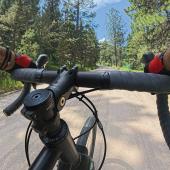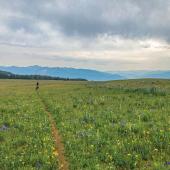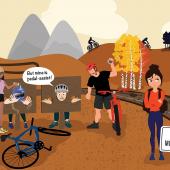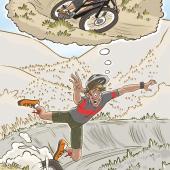Sonic Singletrack
Tuning into the trails at Pipestone.
“This downhill is pretty fun,” Jim says, a huge smile betraying his guarded excitement. “Just watch out for the stream crossing at the bottom.”
And like that, he’s gone, dipping out of sight with Jessica not far behind as I bring up the rear.
Going last, and never having ridden here before, I rely on the hooting and hollering of the riders in front of me, their exultations providing an audio map of the trail’s obstacles, its steepness and difficulty level, the make-up of its dirt. More than visuals, sounds lay out the descent. Screams of joy or grunts of pain—even grumblings of frustration—map the ride. On this particular section, I know I’m in for a treat, even if I can’t see what lies ahead.
I wait 30 seconds then push off.
I focus on sound. A splash reveals a stream, snapping levers and clicking gears an upcoming climb, laughter a descent. Chains rattle against frames as my companions enter a rocky section. The sound stops—hopefully I won’t hear the snapping of tree limbs or the crunch of bone on rock.
Now, I would never advocate mountain biking with your eyes closed, but listening can change your experience and make you a better rider. Trails unfold visually in front of us, but a sound can give us a hint before we reach an obstacle of what’s to come. It can improve our reaction time, making us more efficient. Sound can encourage us when the crest of a climb is out of sight—if we hear our partners laughing or hollering, it means the end is near, that we'll be rolling downhill again soon. Sound prepares us for a transition. While our eyes focus on the dirt below us, our ears pick up the clicking of levers as a chain jumps from one gear to the next. Soon we’ll have to follow suit or risk stalling out.
Sound connects us to our bike as well. The flub-flub-flub of a tube losing air is heard before it is seen. Screeching brakes mean our pads are worn, but when racing down narrow swaths of trail through hardwood forests, we glean that information through a loud whine and not by looking down at our fork. Creaking seatposts and grinding chains tell us far more about the condition of our ride than we could ever know just by looking at it.
As we dip and roll through sublime singletrack, aimless conversation replaces the sound of heavy breathing, an indication that we're riding well and enjoying ourselves and the time spent outside. My friends are around a bend ahead, but I interpret their tones and imagine their faces. I can hear them smile as we rattle, click, snap, and grind through the forest.











